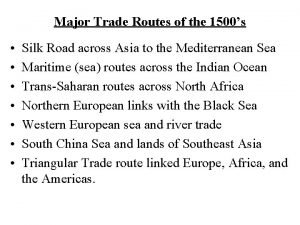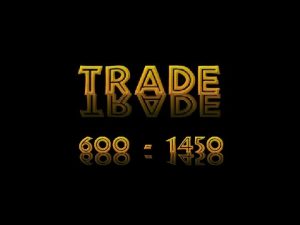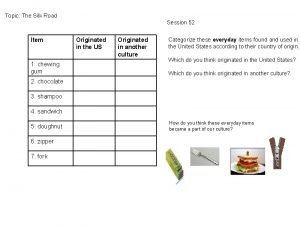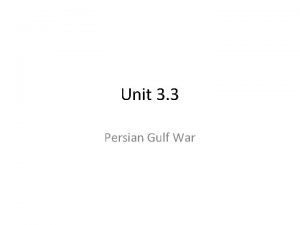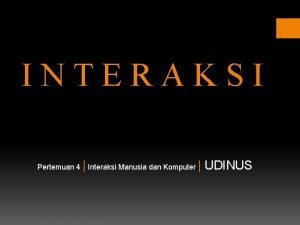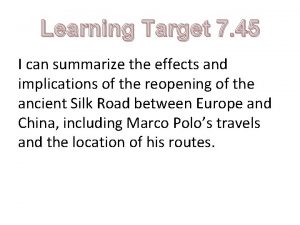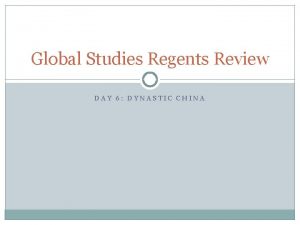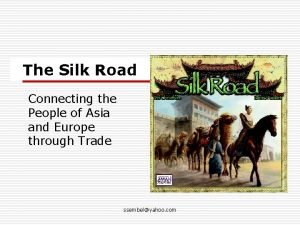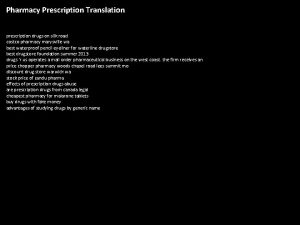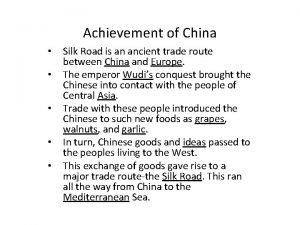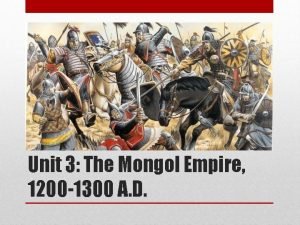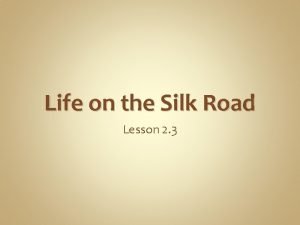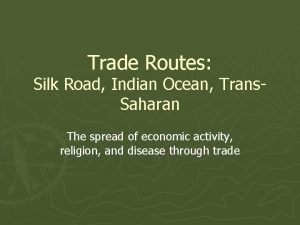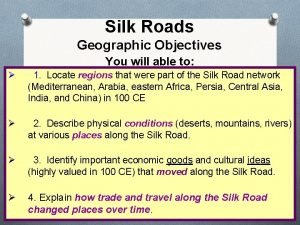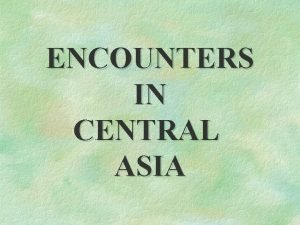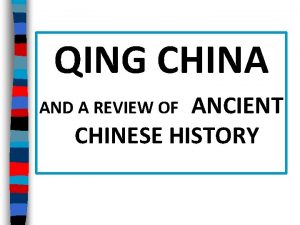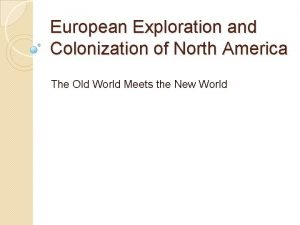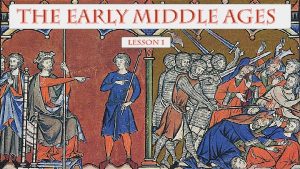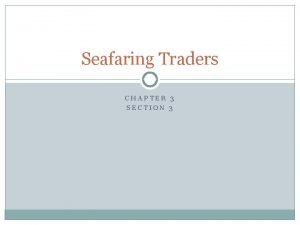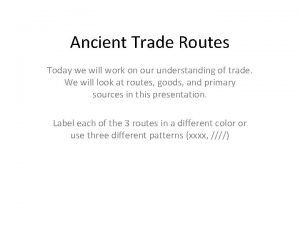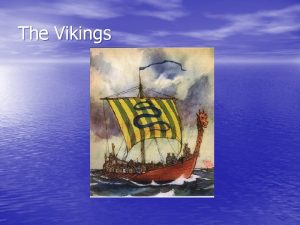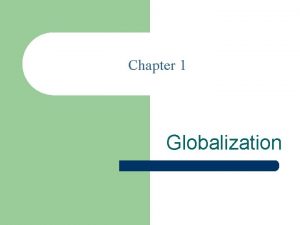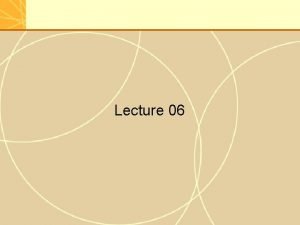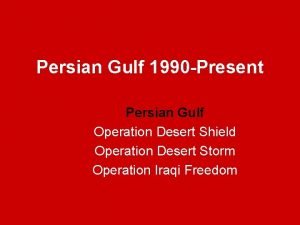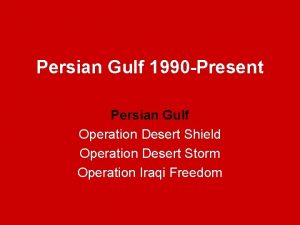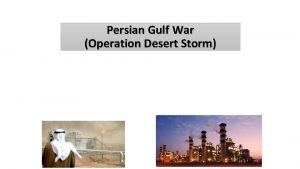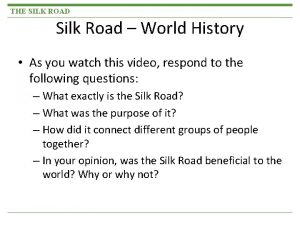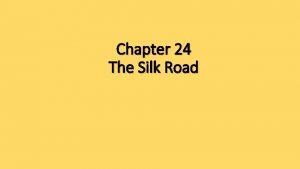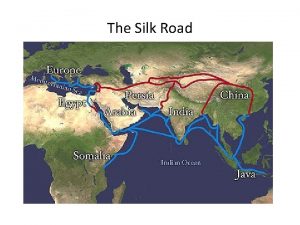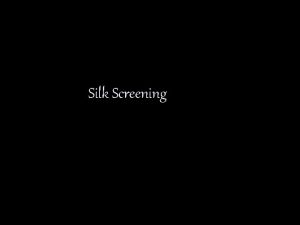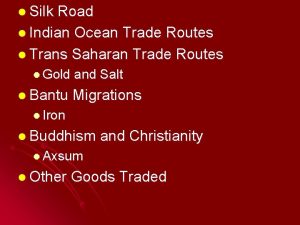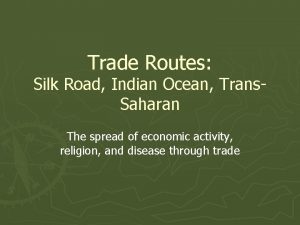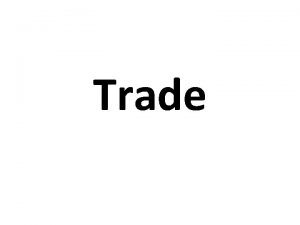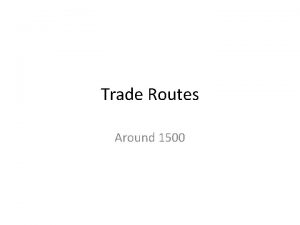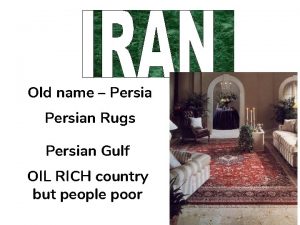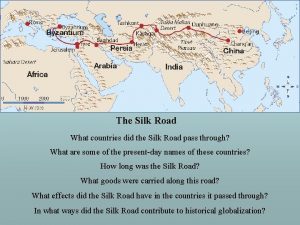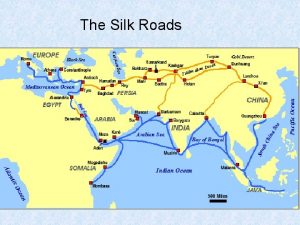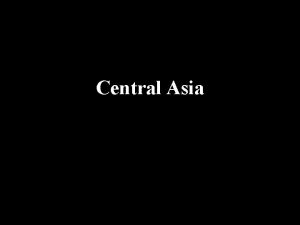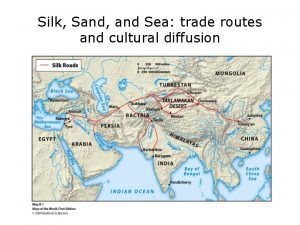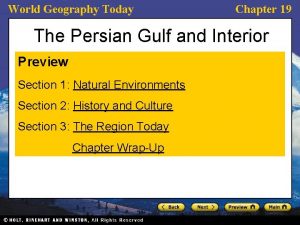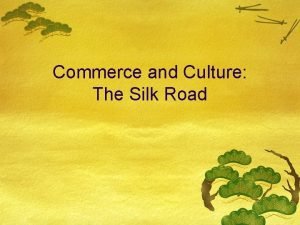World Trade Routes Europe Silk Road Persian Gulf





























- Slides: 29



World Trade Routes Europe Silk Road Persian Gulf Mediterranean Red Sea Trans-Saharan Indian Ocean I, III


Southernization by Linda Schaefer Journal of World History • • by Lynda Shaffer Journal of World History 1994 “a rich south and a poor north” The process of spreading “southern” ideas, technologies, cash crops and mathematics to the “north” Prosperity is linked to warmer temps for the growing of cotton Southernization laid the foundation for westernization

From India: Buddhism Pepper Sugar Cotton “Arabic numerals” “zero” Lentils From China: From Southeast Asia: • paper technology • Nutmeg • iron • Mace • varieties of Buddhism • Cloves • Confucianism • Champa rice • gunpowder, compass • gunpowder, • Navigational techniques • lateen sail From East to West, often the Twain Shall Meet



• Revitalized Silk Road • Expanded military presence to the west • Introduction of “Flying Money” (credit), deposit shops (banks), paper money, and guilds • Construction of Grand Canal • Industrial revolution Paper money – Song China

The Silk Road

• Establishment of Trans-Saharan trade route (gold-salt) • Spread of Islam into sub-Saharan Africa • Rise of Timbuktu and Jenne as trade cities • Use of Niger River Salt slabs to be traded for gold


• Early medieval period v. Most trade local v. Lack of coins v. Political instability – invasions by Vikings, Muslims, Magyars Market in medieval Paris

• Middle Ages v. Agricultural advances = population growth = rise of towns = rise of trade and merchant / artisan classes v. Regional fairs Medieval European Farmers

v. Development of Guilds v. Development of capital and banks v. Rise of Flanders European Guilds

v. Rise of Hanseatic League q. Trade union of Northern European city-states (over 100 cities joined) q. Fight off pirates, other states, create trade monopoly q. Resulted in large middleclass q. Set precedent for large trade operations later used by Dutch and English

European Trade

Hanseatic League

• Location astride major trade routes • State regulated silk trade (silkworms stolen from China) • Trade concessions to foreigners • Trade competition with Venice and other Italian city-states Constantinople

• Aztecs v. Long-distance trade under special group v. Tribute redistribution inhibited development of true markets • Incas v. Little to no long-distance trade v. Tribute and self-sufficiency inhibited development of markets

• Included Swahili coast (East Africa), Red Sea, Persian Gulf, India, Southeast Asia, and East Asia (China) • Dependence on monsoon winds • Spice trade • Use of “circuits” or “zones” – rules of transport • Role of Arabs (Islam) and Portuguese



• Byzantines – location, location • Dominance of Italian city-states (Venice and Genoa) • Muslims • Impact of crusades • Black Sea / Russia - Vikings


History of Essays on this Unit: Trade 600 -1450 COT 2016 Afro Eurasian trade Comp 2015 Biological, commercial or cultural exchanges (Indian, Silk, Sahara) COT 2014 Trade Latin America, Sub-Saharan Africa, SE Asia COT 2013 Mediterranean 200 -1000 C. E COT 2012 Trading networks between Africa and Eurasia circa 300 C. E-1450 C. E COT 2009 Silk Roads COT 2008 Indian Ocean 650 C. E- 1750 C. E


The Silk Route 600 -1450 changed hands from the Muslim and Chinese axis to the Mongol dominance, was initially a dangerous wasteland fraught with warfare but a Pax was established, however goods like silk and perfumes and belief systems like Islam and Buddhism would predominate the region The Indian Ocean trading network 600 -1450 would continue to utilize the seasonal monsoon wind patterns with such notable technologies as the Dhow and the lateen sail, the diasporic Muslim communities would thrive and be guided by sharia law throughout the periodization, however Portuguese merchants would enter in small coastal enclaves by the 15 th century trying to get a stronghold on the spice trade. The Trans-Saharan trade 600 -1450 would be fully integrated into the Muslim trading network bringing Islamic scholarship and regulated by Sharia , however both stateless societies and the commodities of Gold and salt would endure based on their essentiality to their respective societies. The Black Sea trade 600 -1450 would bring the Eastern Orthodox Christian faith to the Russian Principalities, Vikings would trade items with the Byzantine and Arab world, however, trade would be halted at times due to invasions of Turks and Mongols. The Mediterranean would continue to be an essential trading network 600 -1450 connecting Afro Eurasia through Christianity, commodities like glassware and textiles, however the control beginning with the Byzantine would see changing hands through the Islamic world and eventually feudal Europe after the Crusades The Silk Routes and Indian Ocean 600 -1450 both were interconnected through the Islamic trading networks, both utilized technologies like the camel saddles or lateen sail to foster better travel , however the commodities on the silk route would include silks and porcelain while the Indian Ocean was known for the trade of sugar and spice The Trans-Saharan and Indian Ocean 600 -1450 both interconnected Africa through a vast array of Muslim networks guided by Sharia Law, both would see the rise of strong dominant technologies like the dhow and the caravanserai, however, Empires like Mali would rise as the clear power in Sub-Sahara while the diversity of city states (Swahili) and other Muslim merchant diasporic communities would be far more diverse amongst the circuitous routes. The Black Sea and Mediterranean trade 600 -1450 were both interconnected initially by the Byzantine Empire, Christianity would maintain its identity for centuries in both regions (Eastern Orthodox and Roman Catholicism), however, after the Growth and spread of Islam as well as the Crusades, newer trade circuits would expand trade beyond this region. The Aztec trading network and Southeast Asian trading network would engage larger regional territories (Cahokia and Srivijaya), both would use tributary systems to collect resources ( Aztec tribute vs Jizya) however, the Aztec were far smaller in terms of their trade due to the North-South axis pattern of settlement while SE Asia was part of a broader East-West Axis connecting the larger circuits of the Indian Ocean

The Trans-Saharan and Indian Ocean 600 -1450 both interconnected Africa through a vast array of Muslim networks guided by Sharia Law, both would see the rise of strong dominant technologies like the dhow and the caravanserai, however, Empires like Mali would rise as the clear power in Sub-Sahara while the diversity of city states (Swahili) and other Muslim merchant diasporic communities would be far more diverse amongst the circuitous routes The Muslim diasporic merchant communities in important trading cities like Timbuktu and Kilwa would be governed by Sharia and united under the 5 pillars. Facilitating trade with more efficient manners to command the terrain saw the rise of caravans ( and caravanserai) and the Lateen sail on the dhow to get goods efficiently to market. Mali would stand out the hegemonic power along Trans -Saharan trade with their control over gold reserves while multiple Chinese, Muslim, Hindu and Sogdian merchants would see a more diverse array of cultures and goods. The inclusion and integration of Islam as a religion of the merchants facilitated communication and followed a spirit of unity through the Umma or community guiding overland maritime commerce in the post-classical world. The caravanserai were inns for Bedouins and ships of the desert (camels) while lateen sails could manipulate both ways along the Indian Ocean to get goods to market in a timely and fastidious manner more intensively interconnecting the chains of supply and demand The Trans-Saharan trade would be based on the Gold/Salt commercial avenue with only one empire (Mali) providing the basis for Gold exports while the diversity of spice, sugar and silk ( as well as laves ) would see a more diverse group of markets, cities and merchants engaging in diverse trade.
 1500s trade routes
1500s trade routes Persian empire trade routes
Persian empire trade routes Silk road trade route
Silk road trade route Kahoot.it
Kahoot.it Contoh gulf of evaluation and gulf of execution
Contoh gulf of evaluation and gulf of execution Trans-saharan trade route
Trans-saharan trade route Silk road goods traded
Silk road goods traded Which phrase correctly describes the tang dynasty
Which phrase correctly describes the tang dynasty Silk road mind map
Silk road mind map Silkroad pharmacy
Silkroad pharmacy Silk road achievements
Silk road achievements Cambulac mongolia
Cambulac mongolia Silk road map activity
Silk road map activity Silk road indian ocean trans saharan
Silk road indian ocean trans saharan Dunhuang
Dunhuang Silk road map route
Silk road map route Silk road multiple choice questions
Silk road multiple choice questions Persian royal road
Persian royal road Trade routes in the 1500s
Trade routes in the 1500s Ming dynasty trade routes
Ming dynasty trade routes Who paid for jacques cartier's voyage
Who paid for jacques cartier's voyage Why did constantinople become a rich and powerful city
Why did constantinople become a rich and powerful city Chapter 3 section 3 seafaring traders
Chapter 3 section 3 seafaring traders Camel saddle ap world history
Camel saddle ap world history Gupta empire trade routes
Gupta empire trade routes Colonial slavery apush
Colonial slavery apush Vikings original country
Vikings original country Byzantine trade routes
Byzantine trade routes The changing world output and world trade picture
The changing world output and world trade picture The changing world output and world trade picture
The changing world output and world trade picture
